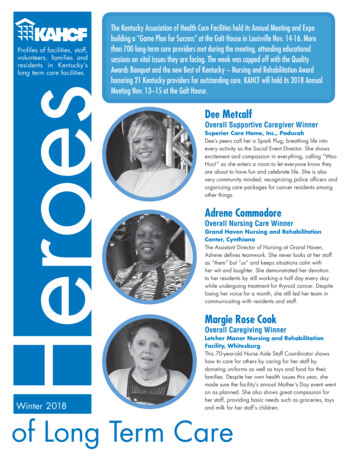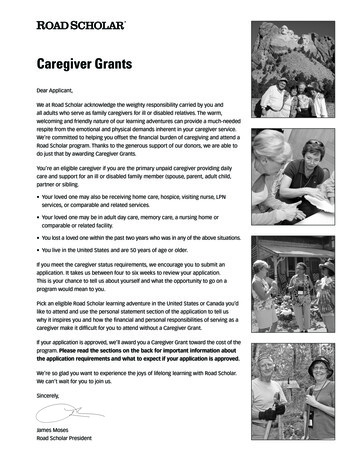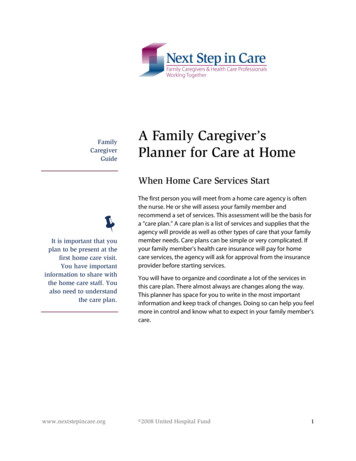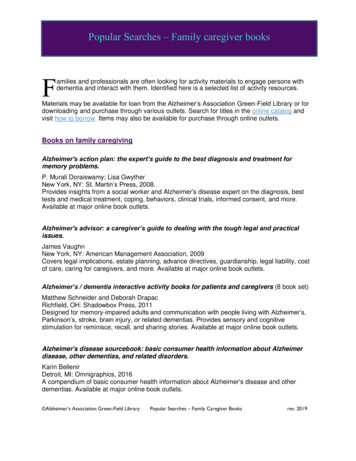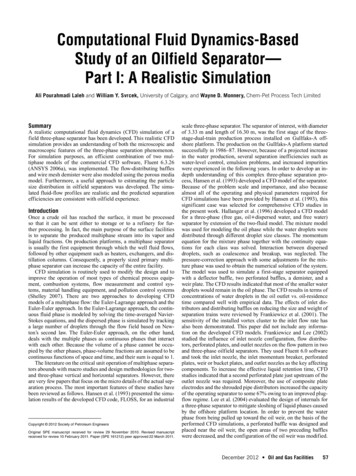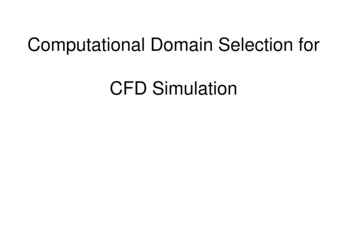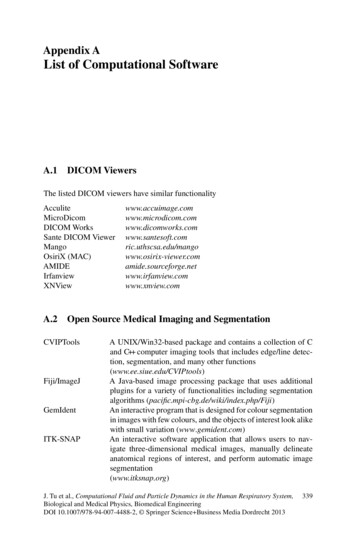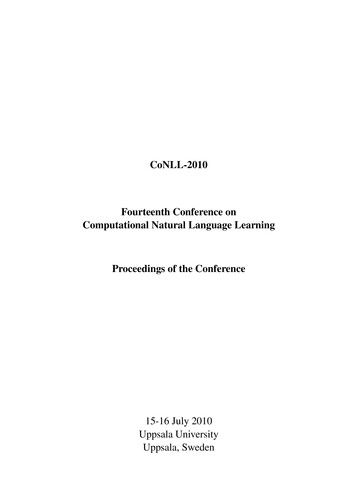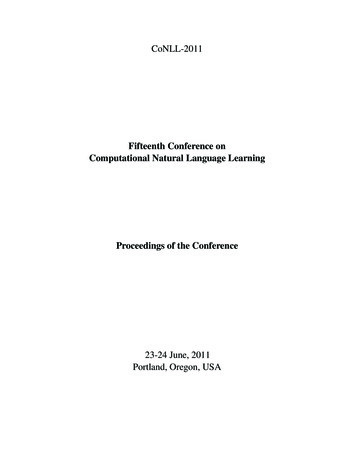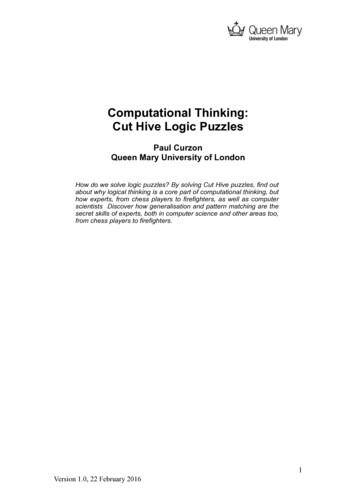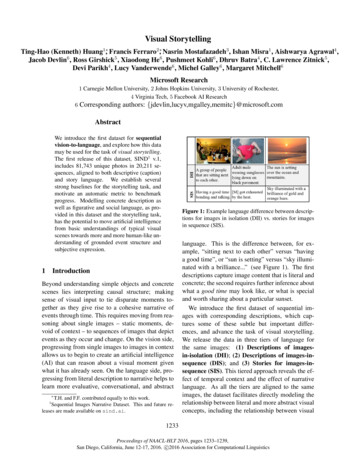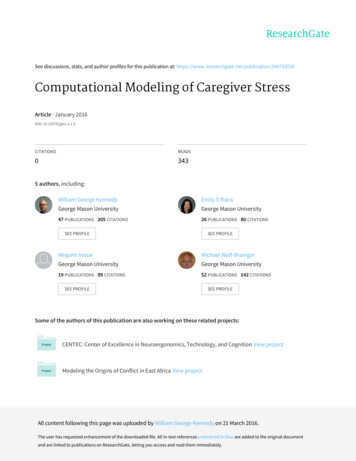
Transcription
See discussions, stats, and author profiles for this publication at: Computational Modeling of Caregiver StressArticle · January 2016DOI: 10.18278/jpcs.2.1.5CITATIONSREADS03435 authors, including:William George KennedyEmily S IharaGeorge Mason UniversityGeorge Mason University47 PUBLICATIONS 205 CITATIONS26 PUBLICATIONS 80 CITATIONSSEE PROFILESEE PROFILEMegumi InoueMichael Wolf-BraniginGeorge Mason UniversityGeorge Mason University19 PUBLICATIONS 99 CITATIONS52 PUBLICATIONS 142 CITATIONSSEE PROFILESEE PROFILESome of the authors of this publication are also working on these related projects:CENTEC: Center of Excellence in Neuroergonomics, Technology, and Cognition View projectModeling the Origins of Conflict in East Africa View projectAll content following this page was uploaded by William George Kennedy on 21 March 2016.The user has requested enhancement of the downloaded file. All in-text references underlined in blue are added to the original documentand are linked to publications on ResearchGate, letting you access and read them immediately.
onal Modeling of Caregiver StressWilliam G. Kennedy, Emily S. Ihara, Catherine J. Tompkins, Megumi Inoue, &Michael E. Wolf-BraniginGeorge Mason UniversityFairfax, Virginia
MODELINGCAREGIVERSTRESS2AbstractCaregivers providing support to family members with Alzheimer’s disease often encounter highlevels of stress within the fragmented long-term care system. To address this emerging issueaffecting millions of families, we applied agent-based computational modeling methods to betterunderstand the impacts of policy alternatives. Potential options include increased respite care, taxincentives, work place policies, and adult day services as alternatives to reduce caregiver stress.Experiments with our model demonstrate that policy options providing programs, services, andsupport for caregivers can reduce their stress by providing a minimum of 16 hours per week ofrespite care.Keywords: Agent-based modeling, caregiving, complex adaptive systems, respite, olderadults, social policy
MODELINGCAREGIVERSTRESS3Computational Modeling of Caregiver StressCaregiver stress is an ongoing and multidimensional issue that will continue to affectmillions of families. A likely contributor to caregiver stress is the fragmented long-term caresystem that has developed over many years to address specific problems without an overarchingdirected effort to create a seamless wraparound approach. Policymakers cannot agree on the bestpolicy solutions, particularly to fund long-term care services. Although there are no easyanswers, agent-based modeling provides a computational method to forecast individual andgroup interactions occurring within dynamic systems, and therefore is an ideal method for testingvarious policy solutions for a complex issue. The increased computational power available toeven the casual user over the past decade facilitates using this bottom-up approach for creatingsimulated environments in which experiments may be conducted. Agent-based modelingprovides an approach for investigating complex phenomena by computationally simulating theinteractions of autonomous agents in order to assess their effect on whole systems. Agent-basedmodels (ABMs) create a “social reality” generated from several variables or inputs. ABMs arecreated to model an environment in which interactions, characteristics, and behaviors ofindividual agents are identified; this leads computational simulations to forecast the emergentbehavior for the entire group.Review of LiteratureSocial work researchers have begun to embrace agent-based modeling. In recent decades,complexity theory, as implemented in complex adaptive systems, has become an acceptednatural science paradigm. Its assumptions, however, have posed significant challenges to itsimplementation in the social work literature. Until the past few years, the application relied on itsmetaphorical use (Bolland & Atherton, 1999; Halmi, 2003; Hudson, 2000; Hudson, 2004;
MODELINGCAREGIVERSTRESS4Trevillon, 2000; Warren, Franklin & Streeter, 1998; Woehle, 2007). Although identified as apromising approach more than three decades ago (Wooldridge, 1981), social science researchersand evaluators have begun to apply this approach to the third pillar of science (after data andtheory). Models are created to simulate an environment or reality, and then experiments are runwithin these environments in order to forecast specific phenomena (Epstein, 1999; WolfBranigin, 2012). Unlike the more widely used systems dynamics modeling (Sterman, 2000)which focus on macro-level system behavior, agent-based modeling starts at the opposite endand models interacting individuals as agents to understand the emergent group rnsresultingfromtheindividual- ‐agent- omodelbuilding(Wolf- ‐Branigin,2013).Agent-based Modeling in Social WorkUseofagent- ‐basedmodelinginsocialservice- ed(Israel&Wolf- udingpublichealthandepidemiology(Auchincloss & Diez Roux, 2008; ein&Axtell,1996).Morerecently,agent- lderadults(Ihara,Horio,&Tompkins,2012).Agent-based modeling has a potential role in detailed policy analysis in the era of bigdata (Couldry & Powell, 2014; Pentland, 2014) because of the increased availability of
MODELINGCAREGIVERSTRESS5individual level data. Problems still exist, however, in matching current modeling schemes andsocial realities (Miller, 2014). In an effort to increase a realism perspective to the developmentand use of this modeling approach in the social policy arena, this methodological article seeks toexplain how to design and document the process of agent-based model building using our modelof caregiver stress as an example.Caregiving for Individuals with DementiaAlzheimer’s disease and other dementias are debilitating, progressive, and costly,affecting individuals, their families, and the long-term care system. Approximately 5.2 millionpeople were diagnosed with Alzheimer’s disease in 2014 and projections are that these rates maynearly triple to 13.8 million by 2050 (Alzheimer’s Association, 2014). Informal familycaregivers provide the majority of care to frail older adults; this assistance is invaluable andfulfills an important role not only for persons with dementia, but also for society as a whole(Robison, Shugrue, Fortinsky, & Gruman, 2014).Dementia caregiving can be a frustrating and difficult experience depending on thesymptoms of the individual with dementia and the environmental supports that are in place toassist the family caregiver. Although many caregivers try to keep their family members out ofinstitutions as long as possible, the absence of relief for the dementia family caregiver may havedeleterious outcomes for both the family caregiver and the individual with dementia. The familycaregiver may experience high levels of stress, depression, and illness (Schulz, Boerner, Shear,Zhang, & Gitlin, 2006), leading to poorer quality of life for both the individual with dementiaand family caregiver and possible early nursing home placement (Benjamin, Matthias, Kietzman,& Furman, 2008; Gaugler, Kane, Kane, & Newcomer, 2005; Yaffe et al., 2002).As Alzheimer’s disease and other dementias progress, behaviors and subsequentcaregiving responsibilities change. In the early stage of the disease, an individual may experience
MODELINGCAREGIVERSTRESS6mild cognitive difficulties, but is typically able to continue to perform activities of daily living(ADLs) and communicate. Caregiving at this stage is often more supportive, helping theindividual cope with memory loss. During the middle stages, damage to the brain may affect aperson’s behavior, ability to communicate, and ability to perform basic tasks. Commonbehaviors as the disease progresses may include wandering, repetitive behavior, physical andverbal outbursts, and sleep changes (Alzheimer’s Association, n.d.). Caregiving at this stageinvolves more hands-on assistance with ADLs, such as dressing, bathing, eating, and grooming.Wandering behavior often creates a safety issue for those living in the community, andpreventing wandering becomes a prime caregiving challenge. For those living alone, theindividual may need to move in with relatives or to a residential care facility.Caregivers unable to provide supervision all day must find a way to keep the individualsafe, and may turn to options such as adult day health care or a personal care aide. The middlestage of the disease typically lasts the longest and may have several crisis points as the level ofindependence decreases. During the later stages of the disease, an individual may have difficultyeating or swallowing, may need assistance with walking, may need extensive personal care, andmay lose the ability to communicate verbally. At this point, the needs of the individual mayexceed the caregiver’s ability to provide the necessary care at home (Alzheimer’s Association,n.d.).Behavioral issues rather than cognitive abilities are more highly correlated with caregiverburden and depression, especially behaviors such as aggression, agitation, and wandering atnight (Gallicchio, Siddiqi, Langenberg, & Baumgarten, 2002; Gaugler et al., 2005; Gonyea,O’Connor, Carruth, & Boyle, 2005; Rinaldi et al., 2005). Appropriate interventions can alleviate
MODELINGCAREGIVERSTRESS7caregiver burden and maintain individuals with dementia at the most appropriate level of care(Etters, Goodall, & Harrison, 2008).Theoretical Framework: Stress and CopingThis study uses Lazarus and Folkman’s (1984) stress and coping paradigm to model thedecision-making process for family caregiving of individuals with dementia across the differentstages. The caregiver stress and coping paradigm depicts the adaptational outcomes related to thestressors of caregiving based on the appraisal, coping responses, and social support of theindividual caregiver. Stressors experienced by family caregivers of people with Alzheimer’sdisease and other dementias include the specific stage of the disease (depicting the severity ofcognitive impairment), behavioral problems such as wandering and aggressive behavior, and theinability to perform activities of daily living (Haley, Levine, Brown, & Bartolucci, 1987).The caregiver’s appraisal of the level of stress he/she is experiencing, the ability tomanage the stress appropriately, and the level of social support that is available determine acaregiver’s decision to move a family member from community-based care to a long-term,institutional caregiving environment such as nursing home placement. In particular, crisissituations can create a sudden increase in stress that is beyond the caregiver’s ability to cope.Interventions that assist the caregiver and prevent inappropriate or unwanted nursing homeplacement may contribute to sustainable solutions that enhance the quality of life for theindividual with dementia and the family caregiver.There are many factors coming into play as family members consider the need forincreased care for frail family members. Ihara, Horio, and Tompkins (2012) conceptuallygrouped variables into two domains – motivation and capability – in their study of grandchildrenopting to provide care for their grandparents. They defined capability as a family member’s
MODELINGCAREGIVERSTRESS8discretionary time and proximity to the frail older family member and motivation as the desireand sense of obligation to provide care after considering the costs and benefits. For the currentstudy, a model was developed to explore public policy options to support family caregiversproviding long-term, family-based, in-home caregiving.Policy OptionsFor our model, possible interventions include increasing options that will support familycaregivers. Policy options such as increased respite care availability, tax incentives, work placepolicies, and adult day health services may support aging-in-place (Chen, 2014). Some of theseoptions are currently available through public laws such as (1) the Family Medical Leave Act(P.L. 103-3), provisions under Title III, (2) Part E of the Older Americans Act related to theNational Family Caregiver Support Program (P.L. 109-365), and (3) the Lifespan Respite CareAct (P.L. 109-442) (Ihara et al., 2012).Unfortunately, home- and community-based services are often out of reach for near-poorolder adults who may not qualify for publicly funded services. Provisions for long-term careunder the 2010 Patient Protection and Affordable Care Act (P.L. 111-148) have provided severalexpansions of home- and community-based services (HCBS) under state Medicaid programs,including the Balancing Incentives Program, the Community First Choice state plan option, andthe home health state plan option (O’Shaughnessy, 2013). These and other programs such as theCommunity Innovations for Aging in Place Program help promote aging in place (Greenfield,2012), but the growing need for services may not match the availability or ability of state andlocal communities to meet all of the demand.In 2009, the National Alliance for Caregiving reported that more than half of caregiverswho responded to a survey asking them to rate six potential policies or programs indicated that a
MODELINGCAREGIVERSTRESS9 3,000 tax credit would be either their first or second choice (National Alliance for Caregiving,2009). To test this policy option, Ihara, Horio and Tompkins (2012) used an agent-based modelto explore the likelihood that grandchildren would become a primary caregiver for a frailgrandparent. They found that a targeted-policy scenario where high-income families do not get atax credit, middle-income families receive a 3,000 tax credit, and low-income families receive ahigher tax credit had better results for motivating grandchildren to become caregivers than theuniversal policy of a flat tax credit for all caregivers.These various policy options potentially are the foundation for the decision-makingprocess of an older adult and his/her family regarding the best living situation includingindependent living, home-based supportive living, assisted living, or nursing home placement.Further, these options may not necessarily alleviate the burden for all families, pointing to theneed to better understand what mix of services and support can enhance the decision forcaregivers and care recipients.Unlike mathematical models of a society, which represent all or large portions of asociety as single unit, agent-based models represent the individuals and emerge their collectivebehavior. This leads to the research question of how to forecast caregiver stress for thoseproviding support to individuals with dementia. We took an agent-based modeling approach andexplain the details on how the model was built, run, and analyzed.MethodsAgent-Based ModelingAgent-based modeling is a computer-based simulation methodology that can supporttesting of policy options. The idea is to formalize processes in a computer program, which canthen be run with different policies implemented and the simulation can report the effects. Such a
MODELINGCAREGIVERSTRESS10simulation includes models, i.e., computational representations, of the conditions and processespeople live in (their environment), the people themselves (called agents), and how they interact.This is not simply having the computer calculate the overall effects through mathematicalformulae for the behavior of the overall system for different initial conditions. The key idea inagent-based modeling is that the modeling is at the level of individual agents who sense theenvironment and respond reasonably. Agent-based models (ABMs) can represent the diversity ina human society and then produce individual and appropriately varied behavior in their responsesto changes in the environment.While modeling cannot provide an exact fit to reality, Epstein (2008) discussed 16reasons, or benefits, for modeling. For the purposes of this paper, the salient reasons foraddressing this topic by modeling include:(1)the tendency of humans to create implicit models in our minds with ABMs beingexplicit and calibrated to actual data;(2)modeling assumptions are laid out in detail so that changes can be observed when theassumptions are altered;(3)sensitivity analysis can be conducted;(4)models can lead to new questions; and(5)modeling enforces a “scientific habit of mind.”Simulated ModelTo focus on the decision-making involved with this topic, we use a mixed approach.Overall, this is an agent-based model (Gilbert, 2008) with the individual agents built on simplesystem dynamics models of their health and stressors. The model is implemented in NetLogo(Wilensky, 1999) and this description of our model is based on the approach described as“ODD”, for overview, design concepts, and details (Grimm et al., 2010) and extended it to
MODELINGCAREGIVERSTRESS11ODD D (Müller et al., 2013), which added a “D” for agent decision-making. This paper is not afull description of the model, but focuses on the agents and their behavior and uses an egocentric approach that models the dyads of older adults and their caregivers. The model and itsassociated ODD D are available on the website Open ABM(https://www.openabm.org/model/4776/).Our notional model has 100 agents representing older adults and approximately 60 agentsas their associated caregivers because approximately 40 of the older adults provide their owncare. This magnitude of these values was chosen to be an appropriate scale for representationalvalidity and to avoid the appearance to precision that is not inherent in the model’s details. Thecaregivers may be family members (spouse, adult daughter, or other kin), professionalcaregivers, or institutions. We could have had many more types of caregivers, but it would beinappropriate given the other modeling assumptions. Each step of the model represents eventsand changes that occur over a year. A year was chosen to be consistent with the level ofprecision for the overall model. Other models could use a time step of a season, month, week, orday, but they would need more reliable models of events on their selected scale. With each step,the general and mental health of the older adults may decline. If conditions change, the providerof the care may change from self to family, from family to a professional, or from a professionalto an institution. The older adult might also pass away during the modeled year. New older adultsare added in each step to keep the population of older adults at a steady count of 100 agents. Themix of care providers is driven by the health of the associated older adult.Agents Representing Older AdultsAgents in the system representing older adults have variables for their age, generalhealth, mental health, and who provides their care. The agents are initialized randomly but are
MODELINGCAREGIVERSTRESS12given characteristics that replicate the population statistics mean and standard deviation asappropriate for the simulated age of the agent (FowlerandFisher,2009). They are alsoinitialized with different levels of physical and mental challenges consistent with the cs,2012). Many are initially their owncare providers. Over time, their need for care due to their general health and level of dementi
Social work researchers have begun to embrace agent-based modeling. In recent decades, complexity theory, as implemented in complex adaptive systems, has become an accepted natural science paradigm. Its assumptions, however, have posed significant challenges to its implementation in the social work literature.
